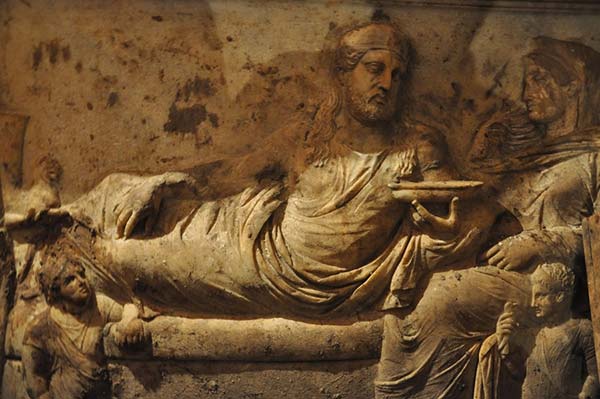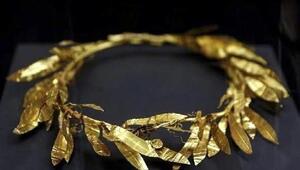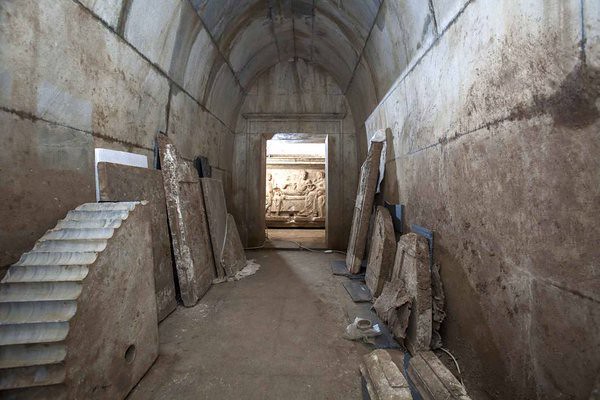Hekatomnos Mausoleum and Sanctuary, which was included in the UNESCO World Temporary Heritage List in 2012, is being converted into an open-air museum with the efforts of the Ministry of Culture and Tourism. The area, which has been excavated by the scientific committee chaired by the Milas Museum Directorate since 2010, will meet with its visitors under the name Uzunyuva Mausoleum Archeopark Area.
The Mausoleum of King Hekatomnus, which is 2,400 years old, is considered even more important than the discovery of Tutankhamon’s tomb, according to some scholars. It was determined that the Monumental Tomb was the inspiration for the 7th Wonder of the World, the Mousoloseum in Bodrum.

The podium of the burial site and the honor column erected in Roman times in the middle of the eastern edge of the podium were discovered during the travel of archaeologist Jacob Spon in 1675-1676. Initially, the structure was thought to be a temple, but it was later revealed that it was a mausoleum and in terms of its architectural form, it pioneered the mausoleums built in later periods.
For whom the mausoleum was built has been the subject of debate. According to the thesis of German archeology professor Frank Rumscheid, who conducted surveys in Uzunyuva, Milas between 1994-1995, the mausoleum is the unfinished building that Carian satrap Mausolos started to have it built for him and his sister and wife Artemisia in Mylasa. . According to this thesis, Mausolos BC. When the capital was moved from Mylasa to Halikarnassos in 367, the construction was also left unfinished and the construction of the Halikarnassos Mausoleum began in the new capital. However, archaeologists who worked in the rescue excavations started in 2010 determined that this mausoleum was built for Hekatomonos, the father of Mausolos.
The burial chamber was discovered in 2010, when illegal excavations were carried out by treasure hunters. The Golden Crown and mountain goat statuette, smuggled from the mausoleum, were found in Scotland in 2018 and brought back to Turkey and started to be exhibited in the Anatolian Civilizations Museum.

HEKATOMNOS TOMB AND THE IMPORTANCE OF THE SACRED AREA
The tomb, located on the eastern slope of Hisarbaşı Hill, dates back to BC. It is dated to the 4th century. The tomb, discovered in 2010, is one of the most important tomb monuments of the ancient world. It is accepted as the ancestor of Halicarnassus Mausoleum, which carries the concept of “mausoleum” and is one of the seven wonders of the world. Its base dimensions are the same as the Mausoleum of Halicarnassus, which was built in the name of Mausolos, the son of Hekatomnos.
The mentioned Mausoleum and Sanctuary; It consists of Temenos Wall, Menandros Honor Column, Podium and Tomb (Carrier Room, Burial Chamber, Sarcophagus and Dromos). Considered one of the seven wonders of the ancient world and carrying the concept of “Mausoleum” (Mausoleum), the monument is unique in that it is the only example that has survived to the present day and belongs to the father of Mausolus in the same dimensions, at an earlier period than the “Mausoleum of Halicarnassus” (Halicarnassus Mausoleum). has a value.
The wall paintings in the burial chamber and the reliefs on the “Frised Sarcophagus of Hekatomnos” are covered with wall paintings at the peak of the Classical age. On the obverse, Hekatomnus is depicted with an offering or a farewell scene; The Frisian Sarcophagus of Hektamnos, on the reverse of which his son Maussollos is depicted while hunting a lion, is the only example in Anatolia due to its size, quality and personality.
In 2014, a 121-line poem was found in the inscriptions around the tomb. The poem, which is accepted as the longest poem of classical antiquity, was written to the ruler.
Especially the “Hekatomnos Frisian Sarcophagus” is the only example in Classical and Hellenistic Anatolia with its size, quality and prominent personality of its owner.
The discovery of the 2,400-year-old Mausoleum of King Hekatomnos, which, according to some scientists, is even more important than the tomb of Tutankhamun, turned the eyes of the world to Milas. The Hekatomnus Mausoleum and Sanctuary was rightfully included in the UNESCO world heritage tentative list in 2012.
The Menandros Honor Column is a Corinthian column erected in the 1st century BC in the middle of the eastern edge of the podium. It is an independent structure from the tomb. It was built by Menandros, the grandson of Euthydemos, the famous speaker and people’s leader of the city of Mylasa. On the column, “The people erected Menandros, the son of Uliades and the grandson of Euthydemus, the benefactor of the country and the son of the benevolent people here as statues.” form inscription. The inscription was first discovered by Richard Chandler in 1775. Chandler noted that the column bears the honor statue of Menandros. The column is called “Uzunyuva” by the local people because a stork makes a nest on it.
Where is Hekatomnus Mausoleum and Sanctuary?
Adres: Hisarbaşı Sk. Hisarbaşı-Hoca Bedrettin Mahallesi, Milas 48200, Türkiye





